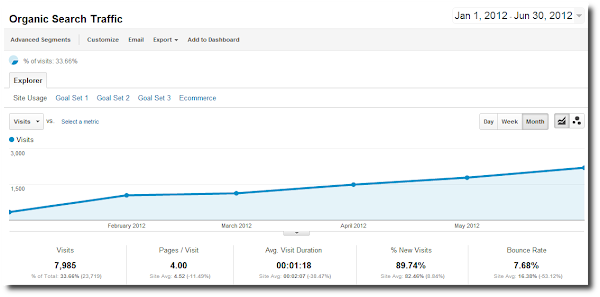Results 1 to 1 of 1
-
28th Nov 2014, 06:46 AM #1
 Best Known SEO Trends Impacting Your Business
Best Known SEO Trends Impacting Your Business

Google makes over 200 algorithm changes a year according to some reports. And many of those updates have the potential to lift you up, or wipe out your traffic literally overnight.
Some large updates, like Panda and Penguin, are big shifts that are well publicized. But many times, Google makes small incremental improvements on a daily basis.
These might not be as noticeable, but they’re always designed as part of a larger trend that will one day heavily influence search results (and they influence how companies should position to protect and capitalize).
Today we’re going to look at 4 key SEO trends impacting your business. And next week we’re going to look at how companies can take advantage of these trends.
Let’s dive in…
Trend #1 – Personalization
The biggest trend we’ve seen over the past year or two is how search engine results are becoming more personalized.
The effects of personalization are already extremely pervasive, and it’s evidence of a much broader, macro-trend that encompass a few other items we’ll discuss below (like localization and social signals).
For example, your past browsing history now dictates which results (and websites) move up or down accordingly.
(So the reason your own company’s website is now showing up on the first page — sorry to say — probably has more to do with personalization and the fact that you visit it every single day, and not the work you’ve done over the last month.)
The impact of this one trend is staggering.
Because things we used to prioritize — like keyword rankings — now mean much less. When everyone’s search results are personalized to their unique tastes and preferences, the idea of a standardized, uniform “keyword ranking” becomes absurd.
Trend #2 – Localization
One of the key drivers behind personalization is the profound impact your physical location has on the search results you’re seeing.
Think of it this way…
Google’s goal is to make search results as personalized as possible (because it provides a better user experience that other search engines — like Bing, Facebook and even YouTube — can’t compete with.)
The only way to tailor your results specifically to your tastes is by layering in other contextual information. And your physical location is a big piece to that puzzle.
Because now Google knows when you type in a generic, informative query like “Pizza”, that you’re most likely looking for local pizza places (and not just a Wikipedia entry about the origins of pizza).
Google is increasingly using this contextual data to infer what you’re looking for (and what you’re NOT looking for).
Trend #3 – Social Signals
The other piece of contextual information that Google uses to tailor results for everyone is their social media influences.
That means they use direct relationships (i.e. who you follow, like, and circle) as well as indirect relationships (i.e. the likes, mentions and +1’s from the people who your friends may follow).
Unfortunately for consumers (but fortunately for companies), privacy online is a thing of the past. Every single thing you put on a free service, like Facebook, will be used against you by advertisers and corporations.
And search engines are increasingly pulling in this data to make sure that they don’t just show you the local pizza shops around your location, but also prioritize your friend’s favorite places first.
Trend #4 – Quality & Qualitivative Signals
Another key shift in search engine algorithms over the past year is the emphasis on qualitative metrics.
Historically, search engines used quantitative information and algorithms to determine the number of backlinks, quality of those backlinks, PageRank, and more.
But Google is also using other means now — like your website statistics and even manual surveys — to measure vague things like “trust” and “user satisfaction” with each result.
The push towards qualitative data came out of the Penguin update, where Google actually used real live human beings to look at different websites and write down their thoughts, experiences, and feelings. These people would answer questions like “Would you feel comfortable giving this website your credit card information?”, or “Would you trust medical advice from this website?”.
This trend hints at the broad scope SEO now tries to encompass, which also tries to value soft-assets like branding with hard ones like backlinks.
Areon Reviewed by Areon on . Best Known SEO Trends Impacting Your Business https://lh4.googleusercontent.com/-CWctdX8vdlI/UGSV1DQz-nI/AAAAAAAABjY/qJUhy1V75FI/s600/FC_-_6_Month_Organic_Search_Traffic%2520-%2520drop%2520shadow.png Google makes over 200 algorithm changes a year according to some reports. And many of those updates have the potential to lift you up, or wipe out your traffic literally overnight. Some large updates, like Panda and Penguin, are big shifts that are well publicized. But many times, Google makes small incremental improvements on a Rating: 5
Sponsored Links
Thread Information
Users Browsing this Thread
There are currently 1 users browsing this thread. (0 members and 1 guests)
Similar Threads
-
New here, but not to SEO. Still request your cooperation
By trafficgusher in forum IntroductionsReplies: 5Last Post: 11th Jan 2012, 09:38 PM -
Best Trustful SEO service Website?
By tooth in forum General DiscussionReplies: 1Last Post: 4th Jan 2012, 03:01 PM -
[Selling] Quality Custom SEO Analysis For Your Website
By raitraak in forum Completed TransactionsReplies: 0Last Post: 21st Aug 2011, 02:40 PM













 Register To Reply
Register To Reply





 Staff Online
Staff Online
themaCreator - create posts from...
Version 3.22 released. Open older version (or...